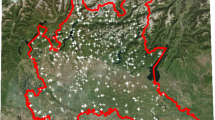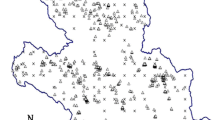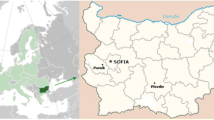Abstract
Indoor radon concentrations depend on building characteristics such as building materials, ventilation and water supply. In this paper, a quantile regression approach is proposed to evaluate the effect of some buildings factors potentially influencing indoor radon concentration. Many of the considered factors, such as soil connection, age of construction and being a single family building, are found to have a statistically significant effect; however, this is far from being constant across the entire support of indoor radon concentration. A potential impact due to geological and geo-physical reasons is also found using the altitude of building locations as a surrogate variable. In addition, a clear local spatial effect is detected by a spatial autoregression approach.








Similar content being viewed by others
Notes
An error of about 20% of the radon concentration measurement has been estimated for the detectors.
It can be noted that the Italian legislation does not define action levels explicitly. In many circumstances, the 90/143/Euratom recommendation is adopted which suggests 200 and 400 Bq/m3 as the reference values for, respectively, the future construction standard and for considering remedial interventions in existing dwellings.
Quite similar rankings are obtained by using different quantiles. For example using the 80th percentile for ranking, the same order is obtained except that profile 3 and 4 are switched as well as 5 and 6.
References
Apte, M. G., Price, P. N., Nero, A. V., & Revzan, K. L. (1999). Predicting New Hampshire indoor radon concentrations from geologic information and other covariates. Environmental Geology, 37, 181–194.
Bochicchio, F., Campos Venuti, G., Nuccetelli, C., Piermattei, S., Risica, S., Tommasino, L., et al. (1996). Results of the Representative Italian National Survey on radon indoors. Health Physics, 17, 741–748.
Borgoni, R., De Bartolo, D., Quatto, P., & Somà, G. (2010). A geostatistical approach to define guidelines for radon prone area identification. Statistical Methods and Applications, 19, 255–276.
Buchinsky, M. (1995). Quantile regression, Box-Cox transformation model, and the U.S. wage structure, 1963–1987. Journal of Econometrics, 46, 109–154.
Cade, B. S., Noon, B. R., & Flather, C. H. (2005). Quantile regression reveals hidden bias and uncertainty in habitat models. Ecology, 86, 786–800.
Cade, B. S., & Noon, B. R. (2003). A gentle introduction to quantile regression for ecologists. Frontiers in Ecology and the Environment, 1, 412–420.
Cole, T. J., & Green, P. J. (1992). Smoothing reference centile curves: the LMS method and penalized likelihood. Statistics in Medicine, 11, 1305–1319.
de Bartolo, D., Alberici, A., Gallini, R., Maggioni, T., Arrigoni, S., Cazzaniga, P., Cugini, A., Olivieri, F., Romanelli, M., Gallinari, G. (2005) piano di monitoraggio per l'individuazione della radon prone areas nella regione lombardia. Atti del convegno AIRP, Catania 15-17 settembre 2005
de Boor, C. (2001). A practical guide to splines. New York: Springer. Revised edition.
Dubois, G., & Bossew, P. (2006). A European atlas of natural radiations including harmonized radon maps of the European Union. What do we have, What do we know, quo vadimus? Italy: European Commission. DG Joint Research Center, Institute for Environment and Sustainability.
Dubois, G., Bossew, P., Friedmann, H., (2007) A geostatistical autopsy of the Austrian indoor radon survey (1992–2002) Science of the Total Environment, 377, 2–3, 378–395.
Franco-Marina, F., Villalba-Caloca, J., Segovia, N., & Tavera, L. (2003). Spatial indoor radon distribution in Mexico City. The Science of the Total Environment, 317(1–3), 91–103.
Heagerty, P. J., & Pepe, M. S. (1999). Semiparametric estimation of regression quantiles with application to standardizing weight for height and age in US children. Applied Statististics, 48, 533–551.
Hendricks, W., & Koenker, R. (1992). Hierarchical spline models for conditional quantiles and the demand for electricity. Journal of the American Statistical Association, 87(417), 58–68.
Kitto, M. E., & Green, J. G. (2008). Mapping the indoor radon potential in New York at the township level. Atmospheric Environment, 42(34), 8007–8014.
Koenker, R., (2005) Quantile Regression. Cambridge University Press
Koenker, R., & Bassett, G. S. (1978). Regression Quantiles. Econometrica, 46, 33–50.
Koenker, R., Mizera, I., (2004) Penalized triograms: total variation regularization for bivariate smoothing. Journal of the Royal Statistical Society Series B, 66, Part 1, 145–163.
Koenker, R., Ng, P., & Portnoy, S. (1994). Quantile smoothing splines. Biometrika, 81, 673–680.
Koenker, R., & Xiao, Z. J. (2006). Quantile autoregression. Journal of the American Statistical Association, 101, 980–990.
Lauridsen, S. (2000). Estimation of value of risk by extreme value methods. Extremes, 3, 107–144.
Lèvesque, B., Gauvin, D., McGregor, R. G., Martel, R., Gingras, S., Dontigny, A., et al. (1997). Radon in residences: influences of geological and housing characteristics. Health Physics, 72, 907–914.
Nazaroff, W. W., & Nero, A. V. (1988). Radon and its decay products in indoor air. New York: John Wiley and Sons.
Powell, JL., (1991) Estimation of monotonic regression models under quantile restrictions, in Nonparametric and semiparametric methods in Econometrics, Barnett, W., Powell, J., Tauchen, G., eds, Cambridge University Press, Cambridge
Price, P. N., Nero, A. V., & Gelman, A. (1996). Bayesian prediction of mean indoor radon concentrations for Minnesota counties. Health Physics, 71, 922–936.
Pandey, G. R., & Nguyen, V. T. (1999). A comparative study of regression based methods in regional flood frequency analysis. Journal of Hydrology, 225, 92–101.
Shi, X., Hoftiezer, D. J., Duell, E. J., & Onega, T. L. (2006). Spatial association between residential radon concentration and bedrock types in New Hampshire. Environmental Geology, 51(1), 65–71.
Smith, B. J., & Cowles, M. K. (2007). Correlating point-referenced radon and areal uranium data arising from a common spatial process. Journal of the Royal Statistical Society Series C, 56, 313–326.
Smith, B. J., & Field, R. W. (2007). Effect of housing factor and suficial uranium on the spatial prediction of residential radon in Iowa. Environmetrics, 18, 481–497.
Yu, K., & Jones, M. C. (1998). Local linear quantile regression. Journal of the American Statatistical Association, 93, 228–237.
Yu, K., Lu, Z., & Stander, J. (2003). Quantile regression: applications and current research areas. The Statistician, 52, 331–350.
Zhu, H.-C., Charlet, J. M., & Poffijn, A. (2001). Radon risk mapping in Southern Belgium: an application of geostatistical and GIS techniques. The Science of the Total Environment, 272(1–3), 203–210.
Acknowledgements
The author warmly thanks ARPA Lombardia for providing the indoor radon gas monitoring survey data, Daniela de Bartolo for her useful comments on data collection, two anonymous referees and the associated editor whose suggestions helped in improving remarkably the quality of this paper and Denise Kilmartin for editing the paper.
Author information
Authors and Affiliations
Corresponding author
Rights and permissions
About this article
Cite this article
Borgoni, R. A Quantile Regression Approach to Evaluate Factors Influencing Residential Indoor Radon Concentration. Environ Model Assess 16, 239–250 (2011). https://doi.org/10.1007/s10666-011-9249-3
Received:
Accepted:
Published:
Issue Date:
DOI: https://doi.org/10.1007/s10666-011-9249-3




